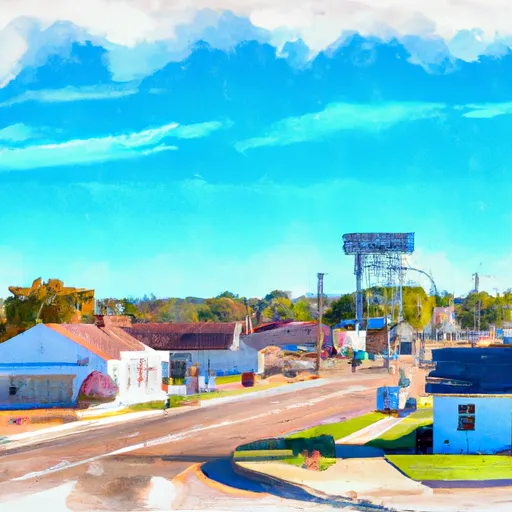-
 Snoflo Premium
Snoflo Premium
Get unlimited access to all our content
With no Ad interruptions! - Start Your Free Trial Login with existing account
Whitesboro
Eden Index
Climate
7.9
•
Recreation
3.7
•
Community
1.1
•
Safeguard
4.7/10

Whitesboro, Oklahoma is a charming town located in the southeastern part of the state. The climate in Whitesboro is characterized by hot summers and mild winters. Summers are typically hot and humid, with temperatures often reaching the high 90s Fahrenheit. Winters are generally mild, with average temperatures ranging from the 30s to 50s Fahrenheit. Rainfall is spread throughout the year, but the wettest months are typically from May to September.
Hydrology constituents in Whitesboro are abundant due to its proximity to the Kiamichi River. The river and its tributaries offer various water activities such as fishing, canoeing, and kayaking. Anglers can find a variety of fish species, including bass, catfish, and crappie.
Outdoor recreation opportunities in Whitesboro are plentiful. The area boasts beautiful natural landscapes, making it ideal for hiking, biking, and camping. The nearby Ouachita National Forest offers numerous trails for nature enthusiasts to explore. Visitors can also enjoy hunting, wildlife watching, and birding in the surrounding forests. Overall, Whitesboro provides a picturesque setting for outdoor enthusiasts to enjoy the region's natural beauty and engage in various recreational activities.
What is the Eden Index?
The Snoflo Eden Index serves as a comprehensive rating system for regions, evaluating their desirability through a holistic assessment of climate health, outdoor recreation opportunities, and natural disaster risk, acknowledging the profound impact of these factors on livability and well-being.
Climate Health Indicator (CHI): 7.9
Whitesboro receives approximately
1288mm of rain per year,
with humidity levels near 80%
and air temperatures averaging around
16°C.
Whitesboro has a plant hardyness factor of
7, meaning
plants and agriculture in this region tend to thrive during the non-winter months.
By considering the ideal temperature range, reliable water supplies, clean air, and stable seasonal rain or snowpacks, the Climate Health Indicator (CHI) underscores the significance of a healthy climate as the foundation for quality living.
A healthy climate is paramount for ensuring a high quality of life and livability in a region, fostering both physical well-being and environmental harmony. This can be characterized by ideal temperatures, reliable access to water supplies, clean air, and consistent seasonal rain or snowpacks.
Weather Forecast
Streamflow Conditions
Red-Little
Area Rivers
Red-Little
Snowpack Depths
Red-Little
Reservoir Storage Capacity
Red-Little
Groundwater Levels
Recreational Opportunity Index (ROI): 3.7
The Recreational Opportunity Index (ROI) recognizes the value of outdoor recreational options, such as parks, hiking trails, camping sites, and fishing spots, while acknowledging that climate plays a pivotal role in ensuring the comfort and consistency of these experiences.
Access to outdoor recreational opportunities, encompassing activities such as parks, hiking, camping, and fishing, is crucial for overall well-being, and the climate plays a pivotal role in enabling and enhancing these experiences, ensuring that individuals can engage in nature-based activities comfortably and consistently.
Camping Areas
| Campground | Campsites | Reservations | Toilets | Showers | Elevation |
|---|---|---|---|---|---|
| City Park Camp - Overton | 40 | 468 ft | |||
| Monticello Park - Monticello Reservoir | 28 | 389 ft | |||
| Billy Creek | 12 | 836 ft | |||
| Cedar Springs - Lake Of The Pines | None | 269 ft | |||
| Winding Stair | 23 | 1,961 ft | |||
| Beavers Bend State Park | None | 460 ft | |||
| Daingerfield State Park | 52 | 402 ft | |||
| Hochatown State Park | None | 640 ft | |||
| Lake Of The Pines | 30 | 253 ft | |||
| Titus County Park | None | 362 ft |
Nearby Fishing
Catastrophe Safeguard Index (CSI):
The Catastrophe Safeguard Index (CSI) recognizes that natural disaster risk, encompassing floods, fires, hurricanes, and tornadoes, can drastically affect safety and the overall appeal of an area.
The level of natural disaster risk in a region significantly affects safety and the overall livability, with climate change amplifying these risks by potentially increasing the frequency and intensity of events like floods, fires, hurricanes, and tornadoes, thereby posing substantial challenges to community resilience and well-being.
Community Resilience Indicator (CRI): 1.1
The Community Resilience Indicator (CRI) recognizes that education, healthcare, and socioeconomics are crucial to the well-being of a region. The CRI acknowledges the profound impact of these elements on residents' overall quality of life. By evaluating educational resources, healthcare accessibility, and economic inclusivity, the index captures the essential aspects that contribute to a thriving community, fostering resident satisfaction, equity, and social cohesion.

